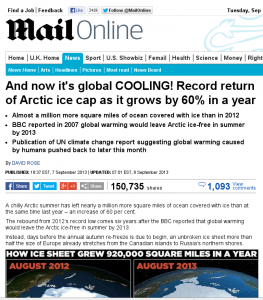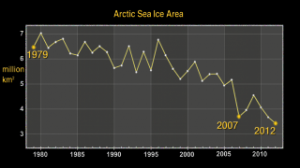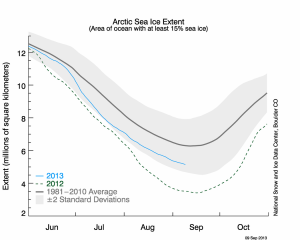
The Daily Mail claims in their science section that the 60% increase in arctic ice extent comparing August of 2012 to August of 2013 means “global cooling” is happening. But is this bad science reporting? Yes. This claim cherry-picks data, comparing only August of 2012 to August of 2013. The article ignores absolute numbers over relative (percentage based) ones, and ignores uncertainty year-to-year in expected average ice coverage, as well as the long-term trends in ice coverage. This article is riddled with the worst kind of pseudoscience.
What is climate, and how is that different from weather?
Climate is the effect of weather aggregated over decades. Weather is the variation in environmental temperature and moisture patterns in a week, a month, a year, and even several years. A lot of news agencies, TV talking heads, and other preachers at their bully pulpit confuse these issues and mistake changes in weather patterns in one or two years for climate.
This mistake has led many in the press to declare all kinds of wrong things about the weather. Hemispherical snobbery has also led people to make mistakes like the declaration that the 1960s-1970s were a time of “global cooling.” Thanks in large part to the dispersion of aerosols into the Northern Hemisphere through the prior decades, “global cooling” was actually confined largely to the Northern Hemisphere that wrought those aerosols and particulates; the Clean Air Act in the U.S. removed those particulates, and the Northern Hemisphere resumed a warming trend that had been mitigated by pollution in the north but was largely unchecked in the Southern Hemisphere (c.f. my old post on this [1]).
The Claim
The Daily Mail has proclaimed, in what is ostensibly their “science” section, that “And now it’s global COOLING! Record return of Arctic ice cap as it grows by 60% in a year.” That might seem impressive – after all, the Arctic Ice Sheet is huge. But the Earth is huger. This is a good example of mistaking something that’s big by human standards as being also big by Earth standards. Such a mistake in framing the scale of things is the first flaw in this piece.
The major flaw, however, is a total misunderstanding of (1) the absolute, not relative, numbers involved (percentages sound impressive, but when it comes to something like sea ice it’s absolutes that matter), (2) trends in climate (which manifest over decades, not in a year), and (3) uncertainty on single-year measurements. It may seem impressively unlikely that the ice sheet could grow by so much in one year; after all, humans live about 80 years (thanks entirely to evidence-based medicine), and such big growth in one year might seem impressive to such a short-lived creature as a human. But the Earth is 4.5 billion years old, and 1 year is as impressive to the Earth as half-a-second is impressive to a human being. That’s the equivalence of one year in the timescale of the Earth to a human being – 0.5 seconds. Would you, in what happens in just one 0.5s of your life, make pronouncements?
Keep in mind that the Daily Mail is comparing numbers using monthly values, picking two months separated by one year. This is akin to making a judgement based on events that occur in less than 0.05s of your life!
The trend in Arctic Ice – monthly, yearly, and by the decade

NASA keeps excellent data on the trends in Arctic Sea Ice extent [1], specifically the area of the ice in units of “millions of square- kilometers,” which I’ll denote as “mk2.” From 1979 to 1984, a five-year period, the average coverage in sea ice was about 6.6 mk2. Year-to-year variations during that period were at the level of up to 0.5 mk2 each year.
Sea ice extent (area) varies month-by-month. It can be big during the Arctic winter months (e.g. 15 mk2) and small during the Arctic summer months (e.g. 5 mk2), so in just 6 months the area can swing by huge amounts. It’s better, as a result, to compare yearly and even multi-yearly means of the ice area, rather than month-by-month numbers. The variations are too large, on a month scale to make ANY conclusions.
Looking at the data, we see the trend takes decades to reveal, but it’s clearly downward and the average amount of sea ice extent is decreasing at an accelerated rate. While the year-to-year average area variations from 1979-1984 were at the level of 0.5 mk2, the total yearly mean sea ice area has dropped from an value of about 6.6 mk2 during that period to about 3.6 mk2 over the last 5 years, excluding 2013 (which is not done yet).
So the drop in mean sea ice coverage has been about 3 mk2 in just about 30 years, or about 1mk2 every decade (on average . . . keep in mind the extent has decreased at an accelerating rate, so most of that loss has actually only been in the last 15 years).
The Daily Mail chooses to quote their claim using relative (percentage) numbers, cherry-picking two specific months rather than using absolute numbers and yearly averages. They claim that sea ice coverage increased 60% between August of 2012 and August of 2013. However, a look at the raw data for 2012 and 2013 [4] shows that for most of 2012 and 2013, the areas have been about the same! It’s only since May that the two sets of numbers diverge, but remember – monthly variations are LARGE and it’s difficult to make conclusions month-by-month using such noisy numbers. Better to take the arithmetic mean, and look at the trend.
So I did that. The trend is clear. The average sea-ice extent in 2012 from Jan-Aug was 11.9 mk2, while the same average in 2013 was 12.1 mk2. That’s not only within the month-by-month noise; it’s within the yearly average noise, too.
This is nicely illustrated by a graph of the averages and the monthly and yearly trends from the National Snow and Ice Data Center [5]:

What about the percent increase? 60% sounds like a big number . . . except that it’s 60% of the smallest ice extent number on record. In fact, it’s not even clear where the Daily Mail’s 60% comes from . . . because it doesn’t come from the data itself. The NSIC numbers report 4.71 mk2 in August 2012 and 6.09 mk2 in 2013. That’s a 29% increase, comparing only those two months. Where they got 60% is unclear.
But, that said, it’s still not impressive. The uncertainty on any single monthly ice extent value, averaged over 1981-2010, is about 1 mk2. That means that monthly variations at the level of 2 mk2 are well within statistical noise (95% confidence level, assuming Gaussian errors). This is a variation of 29% of the 2012 value in August . . . or about 1.3 mk2. That’s pretty unimpressive, as it’s well within the noise envelope.
Conclusions
The Daily Mail article draws wild conclusions about climate by mistaking weather for climate, cherry-picking two monthly arctic ice area values, quoting relative and not absolute numbers, and ignoring uncertainty in measurement. Accounting for those issues, one cannot conclude that “global cooling” is happening based on a single year, and certainly not a single month in a single year. Such a claim ignores the decadal trends in ice extent and basic critical thinking skills. With such blather, The Daily Mail is promoting dangerous pseudoscience and weak sense critical thinking.
[1] http://steve.cooleysekula.net/blog/2010/02/22/thy-will-be-done/
[3] http://svs.gsfc.nasa.gov/vis/a000000/a003900/a003991/index.html
[4] http://nsidc.org/data/seaice_index/archives.html
[5] http://nsidc.org/data/seaice_index/images/daily_images/N_stddev_timeseries.png


